No Sleep For Kaname Date – From AI: THE SOMNIUM FILES review

- 1 Comment
Spike Chunsoft’s third installment sacrifices story depth for an eye-opening collection of escape room puzzles
I’ve been a fan of Kotaro Uchikoshi’s work since I first played 999: Nine Hours, Nine Persons, Nine Doors. That game started the Zero Escape series, a trilogy of adventures based around being stuck in a building with a cast of characters and lots of escape rooms to work through. Then that series ended, and AI: The Somnium Files started, ditching the more traditional escape room mechanics for a divisive, less logical dream-diving mode. That was, until No Sleep For Kaname Date came along and reintroduced the escape room gameplay – to great success, albeit sacrificing some of the more compelling investigative storytelling in the process.
Officially titled No Sleep For Kaname Date – From AI: THE SOMNIUM FILES, this game follows characters established in the first one but with a whole new story. Iris Sagan, internet idol, has gone missing. She’s woken up in what she assumes to be a UFO and is greeted by Akemi, a girl with a lizard tail who appears on a screen and lays out the rules: this is an escape room, and Iris must solve it. She’s allowed help, however, and decides to call Kaname Date, ABIS officer and Psyncer (I’ll get to it). It’s up to Date to help Iris solve her puzzles and figure out just where she is being held – after all, she can’t really have been abducted by a UFO…can she?
Fans of the Somnium Files games will find themselves right at home here. Despite being the third title in the series, players really only need to be familiar with the first game to follow along. No Sleep For Kaname Date takes place after that one, and while characters from the second game show up, you can enjoy their inclusion without knowing who they are. The same can’t be said for the characters returning from the original, and one of this game’s major plot threads picks up from something that happened near the climax of the first one, dealing with some of the consequences of that game’s narrative.
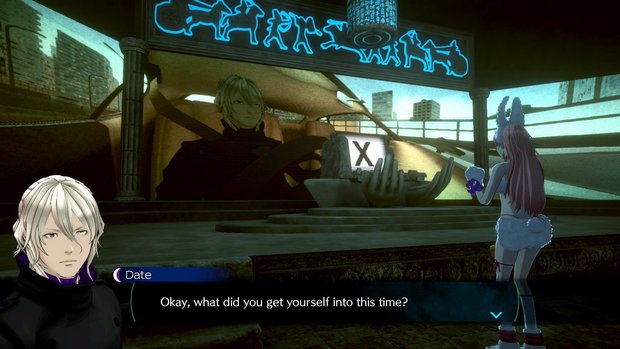
Strangely, No Sleep For Kaname Date seemingly tries to make this a suitable jumping-on point. Characters are vague about the events of the earlier game, as if afraid of spoiling the story for newcomers. Despite this, almost every character you meet is someone who’s had more development previously. There are three new characters, only one of which you spend significant time with, and I really can’t see how anyone could make sense of the story without having played the first.
Clocking in between ten and fifteen hours, this is the shortest of the Somnium Files games. The story here is good, if a little pointless. You aren’t going to be solving any shocking murders this time – you’re just trying to keep Iris alive long enough to find and save her. It gives the whole game an almost slice-of-life feel that never quite hits the same emotional high points that the first game did when it decided to be serious.
Still, it’s a fun time stuffed with escape room puzzles and dream exploration, and I was surprised at how well it captured the humorous tone the first Somnium Files game had – doubly so considering that, for the first time in the franchise’s history, Uchikoshi wasn’t the game’s writer. It doesn't show when it comes to the characters; if you missed the dynamic between Date and his AI assistant, Aiba, you’ll be well fed here. However, the lewd jokes are turned up to eleven. Even I started to question it as I played: had the games always been this perverse?
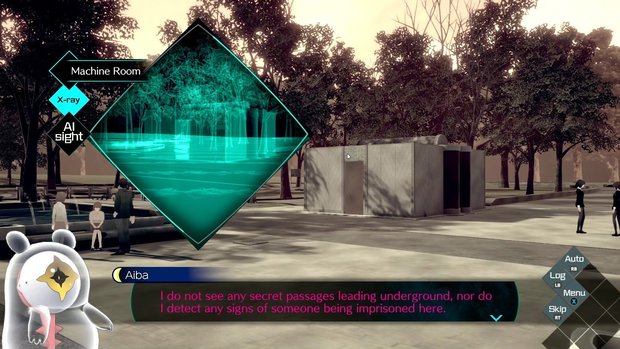
No Sleep For Kaname Date, like the others in the series, is fully voiced and dubbed for English. I played with the English voice acting, something I normally can’t stand in anime and movies. However, the returning cast is once again on point. No line reading ever took me out of the experience, and you can tell just by the performances that the actors had a lot of fun playing their roles.
As mentioned, there are plenty of familiar faces in this game. In fact, veterans of the franchise will recognize many of the assets used here; from locations to characters to music, much of the game is recycled from the previous two. Along with Date and Aiba, we have a majority of the supporting cast returning from AI: The Somnium Files – namely the ABIS crew – and a few characters from the second game, nirvanA Initiative, including its protagonists Ryuki and his AI, Tama, show up playing secondary roles here.
Likewise, every location in Tokyo is reused, from the calm and homely Sagan residence to the Sunfish Pocket concept cafe. This isn't necessarily bad; the second game did a similar thing and the locations are generally bright, full of character and color. Still, I would have enjoyed new areas to explore in the investigative segments. As it stands, the new areas only exist in the escape room and dream world sections of the game.
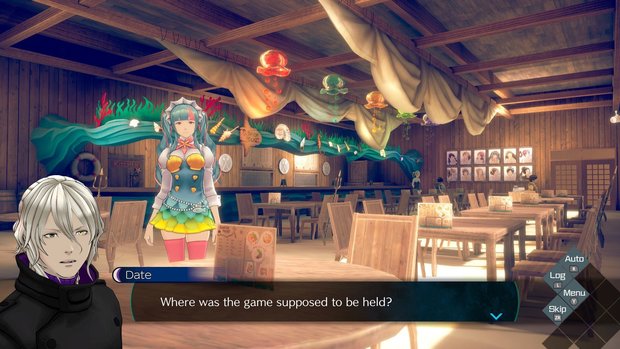
A lot of the music is – you guessed it – recycled, but the tracks still hit. I played the first Somnium Files six years ago and some of the familiar tracks took me back there, in the best way. I really enjoyed some of the new music too: Akemi’s theme is one of my favorite editions, with its whole cyberpunky techno vibe. Fans of the Zero Escape games will also be delighted by the intro to the escape room segments; the sound effects, animation, and even the light musical motif are taken directly from those games.
The gameplay can be broken up into three segments this time: investigation, escape room, and psync. In the investigative segments, you play as Kaname Date as he travels around the city, trying to find where Iris is being held. This consists mostly of traveling to a location via the map and talking to the NPCs there. Once there you take Date’s first-person point of view and can move your cursor around the screen. Occasionally you will need to click on an item, but there’s no inventory or item collection mechanic here.
When you hover over an object that’s interactive, you’ll see a green box with the item name on it. When all commentary is exhausted, this little box will go grey. It’s a feature that was in the other games but it’s still appreciated here, as you’ll get humorous dialogue when interacting with some objects multiple times. Some of the game’s best animation exists in the investigative segments as well. There are some action scenes with very forgiving Quick Time Events occasionally, as Date encounters some armed goons, and they’re very fun to watch. The characters are as expressive as always too. When you talk with them in any of the segments, a headshot will appear in the bottom left of the screen, performing facial expressions that effectively convey their emotions.
Escape room sections are in third person, putting you in control of Iris, moving her with your keyboard or controller (no point-and-click) around the room, trying to find clues and items. The rooms where she’s held captive vary wildly, but they all have the connective theme of the paranormal. The first room is based on ancient alien conspiracy theories, while later rooms are based on things like a cursed box and, to my delight as a fan of internet horror, a room based on a rather infamous 2chan creepypasta. You have an inventory here with an item-combining mechanic (all common sense, like putting two halves of a statue together). These segments don’t skimp on the puzzles either. Among many others, you’ll need to think about how a cube would look unfolded, solve a deductive logic puzzle, and a version of the ancient game of senet appears here as well.
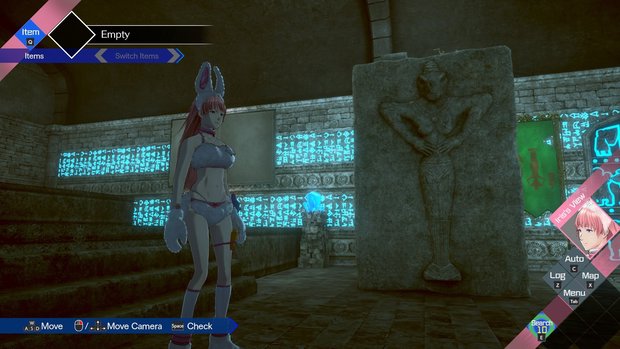
I found it very handy to have a pen and paper for remembering codes, and I still had trouble on the last part of the first room. If you are struggling, there’s a “Search” button that will show you interactive points of the room. You only get ten chances to use this button on the standard difficulty, though there is an “Easier” difficulty option that increases that number and a “Story” option that removes the limit and will even give you the solution if you struggle too much on one puzzle.
These escape room segments were the most enjoyable part of the game for me, gameplay-wise. It’s something that the other two entries in the series were missing, and it really harkens back to the Zero Escape trilogy. Having logical puzzles to solve in this series is refreshing; never was I upset at the game when I finally learned the answer to a puzzle I struggled with. All of the solutions make sense, and if I got stuck I could only blame myself. I hadn’t realized how much I had missed segments like these until I got to play them again.
That isn’t the case with the psync segments. Being a Psyncer, Kaname Date can use a special machine to enter people’s dreams. There you’ll control his AI companion Aiba, who exists in the real world as Date’s eye implant but here takes the form of a girl. These sections again use a third-person perspective, very similar to the escape room segments. What differs is the addition of a time limit; you can only stay in the dream space – or somnium– for six minutes. If that time runs out (and on a first playthrough it will; every interaction and even moving will drain your time) you’ll fail the section and either have to load a checkpoint, or more likely, restart the whole psync.
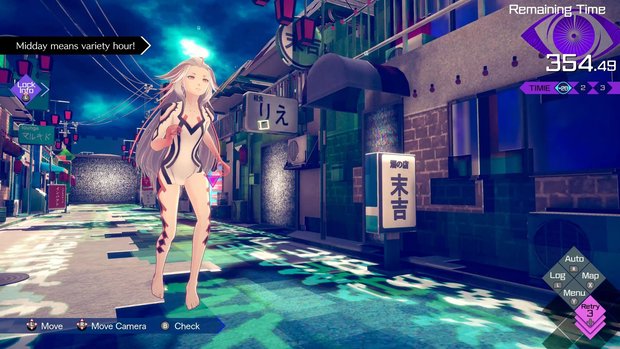
If you didn’t like these segments in the other games, you won't like them here because they feel even more punishing. I had to restart each psync at least once. I’d get near the end, fail, and realize I had softlocked the run by wasting time near the start trying to figure out what I needed to do to progress. Trial and error is the name of the game here. On rare occasions I could get myself into the same dream logic headspace the game was operating on, but for the most part I just had to run through and remember what worked for my next attempt.
Perhaps the most interesting part of the somnium sections are the story reasons behind their inclusion here. There’s no split narratives or timeline jumping in No Sleep For Kaname Date, just a straightforward story. However, early on in the search for Iris, Date comes across a large pod in a warehouse with a note on it– “Psync with me”. And that’s exactly what you’ll do; you don’t know whose dreams you're entering, and it’s fun to try to guess who’s in there as more and more clues pop up. That’s the main goal of the somnium sections here: trying to figure out just who is in this pod and how they’re related to the disappearance of Iris.
While we do get some new somnium areas – there’s a Ninja Warrior-esque segment in one of the dreams I quite enjoyed – we get some old ones here too, like the Bloom Park merry-go-round yet again, albeit with a new coat of paint and giant spinning wheel added. I’m more forgiving of the repeat assets here, though, as at least in these segments when environments are reused, they usually have a new palette full of vivid colors and some new, dream-like objects in the environment. The animation in the somnium sections is still done rather well too. There are lots of humorous cutscenes that play depending on the choices you make. Many actions can lead to a slapstick scene of Aiba winding up flat on her face.
Still, the somnium sections can be frustrating, so thankfully there’s not too many of them, and having the more logical escape room sections breaking them up is very much appreciated. The variety is important because this game is a bit more formulaic and linear than its predecessors. I found the mystery compelling at first, but the longer it went on, the more predictable it became. By nature of its placement in the timeline, nothing too crazy can happen here. After all, there’s a game that takes place after this one with a lot of the same characters returning. Still, I enjoyed my time with it. Controlling Date and having access to his and Aiba’s constant thoughts on everything was something I missed when I played the second game, so it’s a joy to have them back front and center here. The two have an antagonistic partnership that can lead to some fun comedy while still obviously caring about each other a lot.
It all wraps up in a nice way, even if the game’s own characters admit the whole thing is rather pointless in the end. I left the game not with the impression that I had solved a huge complicated mystery, but rather that I had just hung out with a bunch of old friends. I think fans of the franchise will appreciate that lighter tone, even if it’s less engaging at the end of the day.
There’s even a bunch of comical joke endings you can get by pestering certain NPCs or clicking on an object enough times at certain points. The production value on some of these short fake endings is higher than I would have expected; on more than one occasion I got an entire animated cutscene for my efforts. Once you finish the game, you can visit the chapter select to see if you missed any of these alternate outcomes and can go back to try to get them. There’s a bonus menu too, where players can unlock and watch humorous scenes with points they can acquire during the somnium segments by choosing certain actions or finding hidden objects. This gives the game a bit of replay value as you won’t be able to get all the points in a somnium segment on a first run.
Final Verdict
All in all, No Sleep For Kaname Date is a game for fans only, because you’ll need to be familiar with the first game to get the most out of it. It really did feel like I was playing an extended bonus epilogue case for the original. But even with lots of reused assets it’s not simply more of the same, for better and for worse. The psync mechanics and investigative gameplay are the same as ever – and in the case of psyncing maybe even less forgiving in this entry – but the story is much more streamlined than ever before, while the addition of the escape rooms takes a welcome page out of the developer’s Zero Escape playbook. It might be a lighter case, without all the fun timeline shenanigans, but it’s always a good time hanging out with Date and Aiba and all their friends. I’d gladly welcome more games in this style, though maybe with more original content next time.
Hot take
Though the story of No Sleep For Kaname Date is pared down and the psync segments are still as frustrating as ever, the first Somnium Files game not written by Uchikoshi is still an enjoyable romp thanks to its added escape room gameplay and sense of humor.
Pros
- Always fun to watch Date and Aiba bicker
- Localization and voice acting remain outstanding
- Escape room segments are a welcome addition to the formula
- Puzzles can be difficult, in the best way
Cons
- Psync segments are back and less forgiving than ever
- Lewd humor is a little much
- Reuse of assets makes the investigations feel a little less special
Micah played No Sleep For Kaname Date – From AI: THE SOMNIUM FILES on PC using a review code provided by the game's publisher.











1 Comment
Want to join the discussion? Leave a comment as guest, sign in or register.
Thanks for the review. If I may be more cynical, I don't think I've loved a Kotaro Uchikoshi’s game since I first played 999. But I keep playing them anyway! I was looking forward to the writing staff refresh, so it's a shame it sounds lacklustre. I'll check this game out.
Reply
Leave a comment